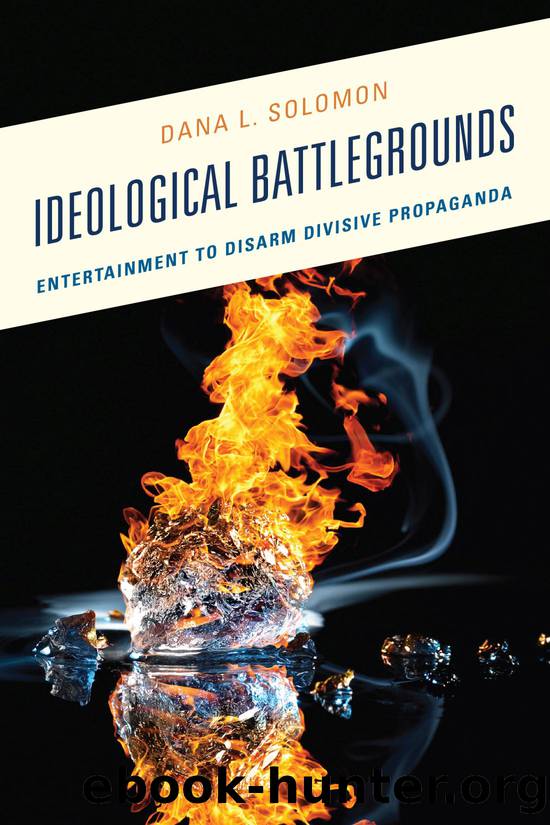Ideological Battlegrounds by Solomon Dana L.;

Author:Solomon, Dana L.;
Language: eng
Format: epub
Publisher: Lexington Books/Fortress Academic
Chapter 12
Multiple Perspectives
Cohen et al. asks, âHow can performances be crafted to bolster and celebrate the unique identities of distinct groups while also acknowledging the interdependence among adversaries?â1 Unfortunately, there is no performance or production that is capable of representing the full range of complexity and perspectives inherent in an ideologically entrenched conflict. Any relevant production, however, can be informed by the intricacies and idiosyncrasies, and represent them in the way that the arts have often represented lifeâas a microcosm of possibilities. Moreover, every conflict, every situation will require a different kind of representation, tailored to its specific needs. While it would be pleasant to be able to create a âone size fits allâ approach to creating ICE, the result would be an ill-fitting, awkward, and likely unappealingly bland or didactic production that represented only the most superficial of issues.
Transformative performances can counter some of the most psychologically challenging influences of entrenched conflicts.
In zones of violence and oppression, suppressed truths about abuses of power, unexpressed stories of suffering, unremembered erasures, unmourned losses, unresolved conflicts and dilemmas, unpunished crimes, unfulfilled yearnings, unacknowledged complicities, unspoken feelings of remorse, and unreconciled relationships are all screamingâin silence and in deafening roarsâfor focused, creative attention that might lead to healing and justice, and, perhaps, to peace.2
ICE can also counteract some of the negative effects of the media, which is often a main source of information about the âotherâ in a conflict,3 abounding with negative, prejudicial and stereotypical representations.4 Performances should invite audiences to engage with visions of the conflict, and those participating in the conflict, that diverge from their own.
PARALLEL NARRATIVES AND ICE
There are a myriad of possible ways to create ICE that embody the principles outlined thus far. Selecting the best approach will depend on the needs of the specific issues one is attempting to address. The Arab-Israeli conflict presents a number of unique challenges that help to refine the possible approaches to ICE. The ideological climate surrounding perspectives on the Arab-Israeli conflict has become so polarized that finding common ground between the various narratives is, at present, almost impossible.5
Given this difficulty, Sami Adwan and Dan Bar-On posit that it may not be necessaryâas a first stepâto present a common historical narrative or find common ground between the conflicting sides, but rather that the initial process of reconciliation should encourage the acceptance of different perspectives on the same facts.6 They utilized this model to createâin collaboration with a number of Israeli and Palestinian educatorsâa revolutionary textbook in which âeach side, Palestinian as well as Israeli, presents its own narratives.â7 The textbook, titled Side by Side: Parallel Histories of Israel-Palestine literally presents two, often conflicting, narratives of the Arab-Israeli conflict side by side, with the Israeli narratives printed on the left hand pages and the Palestinian on the right. This textbook countered what the authors perceived as the existing trend in educating about the conflict in which the narrative of the âother,â if presented at all, is âpresented as being morally inferior. The enemy is depicted as faceless and immoral, with irrational or manipulative views.
Download
This site does not store any files on its server. We only index and link to content provided by other sites. Please contact the content providers to delete copyright contents if any and email us, we'll remove relevant links or contents immediately.
| Anthropology | Archaeology |
| Philosophy | Politics & Government |
| Social Sciences | Sociology |
| Women's Studies |
Cecilia; Or, Memoirs of an Heiress — Volume 1 by Fanny Burney(32074)
Cecilia; Or, Memoirs of an Heiress — Volume 3 by Fanny Burney(31469)
Cecilia; Or, Memoirs of an Heiress — Volume 2 by Fanny Burney(31419)
The Great Music City by Andrea Baker(30795)
We're Going to Need More Wine by Gabrielle Union(18641)
All the Missing Girls by Megan Miranda(14785)
Pimp by Iceberg Slim(13797)
Bombshells: Glamour Girls of a Lifetime by Sullivan Steve(13698)
Fifty Shades Freed by E L James(12924)
Talking to Strangers by Malcolm Gladwell(12888)
Norse Mythology by Gaiman Neil(12858)
For the Love of Europe by Rick Steves(11554)
Crazy Rich Asians by Kevin Kwan(8898)
Mindhunter: Inside the FBI's Elite Serial Crime Unit by John E. Douglas & Mark Olshaker(8718)
The Lost Art of Listening by Michael P. Nichols(7169)
Enlightenment Now: The Case for Reason, Science, Humanism, and Progress by Steven Pinker(6879)
The Four Agreements by Don Miguel Ruiz(6324)
Bad Blood by John Carreyrou(6284)
Weapons of Math Destruction by Cathy O'Neil(5844)
